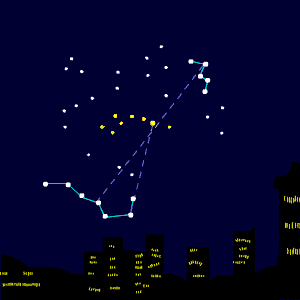Circumpolar (astronomy)

In astronomy , those astronomical objects for a certain place on earth are called circumpolar (from Latin circum "around" and ancient Greek πόλος pólos "earth, celestial axis, north / south pole"), which are located near the celestial pole and not go down . In connection with stars one speaks of circumpolar stars , in connection with constellations of circumpolar constellations .
Since the earth rotates , the celestial objects apparently describe circular paths, the centers of which lie on the extended earth axis (the celestial axis).
Objects whose declination is greater than are circumpolar at observation locations in the northern hemisphere of the earth with latitude . Similarly, objects with a declination smaller (southern latitude with negative numerical value) are circumpolar at observation locations in the southern hemisphere . Objects whose circular path intersects the horizon will temporarily disappear underneath, that is, rise and fall .
For circumpolar objects in the northern hemisphere:
and for the southern hemisphere:
At the north and south poles , all visible extrasolar celestial objects are circumpolar, but none at the earth's equator . Between the poles and the equator , the proportion of circumpolar objects decreases towards the equator.
Certain stars in the circumpolar region have always been of great importance for geographical and temporal orientation, as they are visible at night throughout the year.
In the northern hemisphere of the earth, the pole star and thus the north direction is determined as follows:
- The North Star is located roughly in the middle between the Big Bear (Big Dipper) and Cassiopeia , the “Heaven-W”.
- The Pole Star is the main star of the Little Bear (Little Dipper), but it is not as easy to spot as its larger neighbors Big Bear and Cassiopeia.
- The distance between the rear box stars of the Big Dipper is extended five times in order to get to the position of the North Star.
- The second smear of the "W" of the cassiopeia is extended upwards about 4 times and turned slightly to the right.
See also
literature
- Jeffrey O. Bennett, Harald Lesch (ed.): Astronomy the cosmic perspective . 5th edition, Pearson Education Deutschland GmbH, Munich 2010, ISBN 978-3-8273-7360-1 .
- Adalbert Prey: Introduction to Spherical Astronomy . Springer Verlag Wien GmbH, Vienna 1949.
Web links
- Circumpolar star in "Redshift Lexicon" , accessed on March 4, 2016
- Astronomical Coordinate Systems , accessed March 4, 2016
- Introduction to Astronomy and Astrophysics I , accessed March 4, 2016




